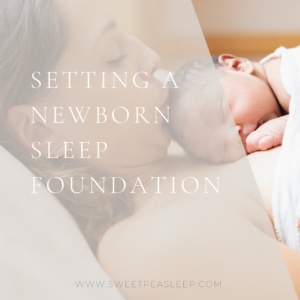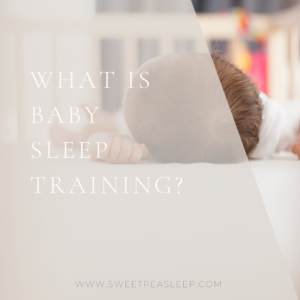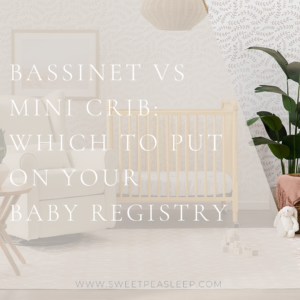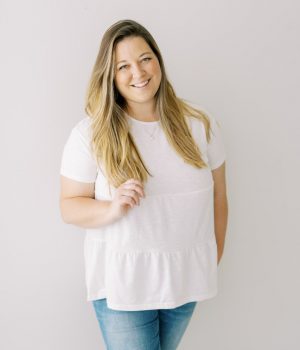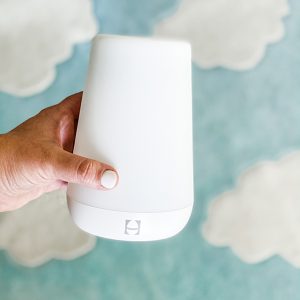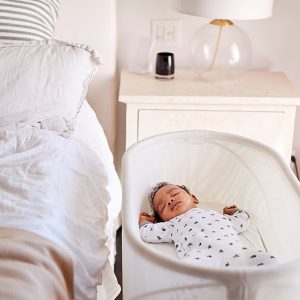
Written By: Kristina James
Kristina lives on the East Coast with her son and daughter and loves to help clients' families reach their full potential!
If you have found yourself wondering what baby sleep training is, you’re in the right place. Baby sleep training is helping babies become comfortable with falling asleep independently. Sleep training is a behavioral intervention that can be beneficial when habits have been established that make a baby reliant on support to fall asleep or return to sleep like rocking to sleep, nursing to sleep, or bouncing to sleep. These are not “bad” habits, but are simply habits that parents may eventually find is causing sleep disturbance and want to change. During sleep training you can work on supporting your baby by providing an age appropriate schedule, an optimal sleep environment, and plenty of practice falling asleep while still responding and comforting them as needed.
Our habits affect our sleep, just as they affect our baby’s. You can think of sleep training as unlearning habits that are not supporting good quality sleep, and establishing habits that will.
Why is sleep training helpful?
Research shows that parental presence at the time a baby or child is falling asleep is strongly correlated to increased night wakings. In other words, the data shows us that parents or caregivers playing a significant role in helping a baby fall asleep at bedtime, will mean that when the baby wakes in between sleep cycles in the night, they will often need similar support to fall back asleep. If you’re wondering if you can avoid waking in the night all together, we cannot. We all do it! In between each sleep cycle we have a brief awakening and then go back into cycling through other stages of light and deep sleep. This is biologically normal. However, for many children and adults, this waking is brief and unremarkable, and we go right back to sleep once we have the skillset to do so.
Sleep training your baby can result in increased sleep quality and quantity for your baby and the whole family, as they can return to sleep without parental assistance in the middle of the night.
Additionally, when babies settle themselves independently for sleep, their cries in the night become more clear signals for other things. For example, if your baby is a consistently independent sleeper and they are crying out in the night you’ll be able to tune into their other needs such as a dirty diaper, illness, pain, or teething, more easily.
Does Sleep Training Mean Cry-It-Out?
Sleep training absolutely does not have to mean cry-it-out! There are many methods of helping a baby to be more independent with sleep that don’t resemble the more “old school” version of sleep training that just involved shutting the door and letting the baby work it out on their own. I fully believe that- with patience and consistency- every parent can find an approach to independent sleep for their child that fits their parenting style and their child’s temperament.
Where do I start with baby sleep training?
If you are ready to get started there are many options to teach your baby to fall asleep and return to sleep independently. Sleep training methods range from very gradual to very efficient but ultimately all methods aim to help your baby learn to fall asleep in their own space and resettle themselves when they wake in the night or between sleep cycles during a nap.You can select the method that best suit the needs and temperament of both you and your baby. Here is a list of some methods you may choose to research further:
Low Tears and Gradual Options:
- No Cry Method: Developed by Elizabeth Pantely. A gradual approach with minimal crying. This approach includes a gentle nighttime routine and swift responses to cryings
- Pick Up, Put Down: in this method you will pick up baby to soothe during crying, and put back in the crib until he has gone to sleep
- Shush/Pat: used to calm and reassure baby by shushing and rhythmically patting them
- The Soothing Ladder: from The Happy Sleeper. In this method you will respond to your baby’s cries with the least support possible, and only increase support when necessary. You will begin with your presence in the room, increase to the use of your voice and escalate from there.
Camping Out Methods:
- The Chair Method: In this method you will put your baby in their crib and sit in a chair next to the crib, each night or two the chair will move farther from the crib until you are out of the room
- In-Room Intervals: You will stay in the room but not go over to soothe for a set interval, intervals will length over the course of the nights you are training
Checking Methods:
- Ferber: In this method you will leave the room for set periods of time and return to reassure your child with a sleep phrase briefly and leave again. They are learning to go to sleep independently, with only the tools they will have on their own at night
There are other methods available depending on the needs of your family and methods can also be combined to create a hybrid solution that may work best. You can research these methods or work with a sleep consultant to develop a custom sleep plan to help give you and your baby the support you need to establish these new habits.
I’m Not Ready to Sleep Train – What Else Can I do?
You can alway focus on non-behavioral strategies that will work with your baby’s body to promote good sleep. These are great strategies to implement with or without formal sleep training:
Provide an optimal sleep environment:
- Cave-like darkness
- Cool
- Quiet, or utilize white noise to minimize outside disturbances
Implement an age-appropriate schedule: keeping your baby awake for age-appropriate wake times, offering sleep at the appropriate time, and setting a bedtime that is inline with their circadian rhythm. If you are wondering what the age-appropriate schedule is for your baby, use our free sleep schedule calculator.
Create a predictable and consistent bedtime routine: A wind down bedtime routine can help your baby sleep better and help them transition more seamlessly from wake time to sleep. Your bedtime routine should start about 30 minutes before bedtime or 45 minutes before if you include a bath. Feeding should ideally be at the beginning of the bedtime routine, to minimize the association with feeding to sleep.
Get in Touch
If you would like support sleep training your baby, the team at Sweet Pea Sleep would love to help you! Together we can identify a sleep plan to teach your baby the skills they need to fall asleep independently. You can fill out the form to get in touch with our team or email me at kristina@sweetpeasleep.com.
